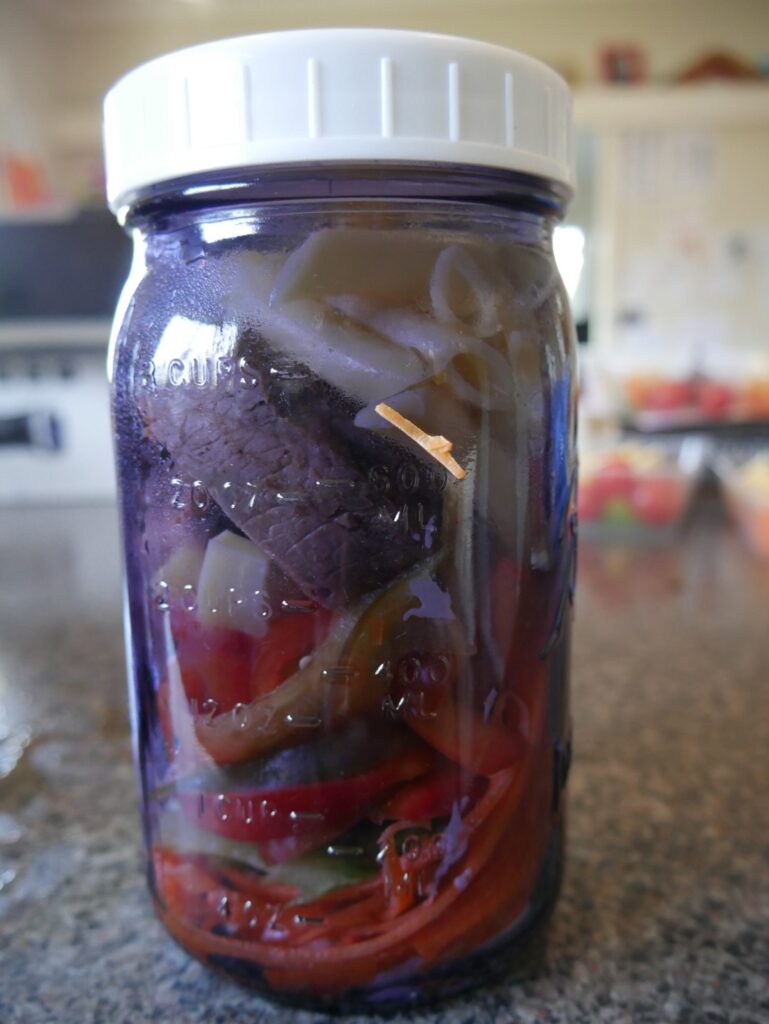The Salad Jar Idea
The basic principle
The idea of a salad jar is to layer salad ingredients in container in a particular order. When it is time to eat; give the jar a shake to mix the dressing and ingredients together.
With a normal salad; the dressing goes on last so not to leave the ingredients soggy after a period of time.
With salad jars; the dressing goes in first at the bottom of the jar.
After the dressing – the jars are layered with the rest of ingredients; working from hard vegetables like carrot, capsicum, celery and then moving up to more delicate ingredients.
At the top should be delicate ingredients like lettuce and crumbly feta.
The idea that the dressing can “pickle” your harder vegetable and this layer of vegetables serves as a barrier to the other ingredients.
The Jars
Any jars or containers with a tight lid will do. After some iterations of different jars; I came to like these squarish mason preserving jars that I found on ebay:

These jars tick a couple of boxes:
- The right size for a lunch
- Relatively solid – can survive a few knocks
- With the jar’s square shape; it packs more efficiently in the fridge compared to round jars
I also brought some plastic lids instead of using the canning lids that came with the jar; as the dishwasher was tearing the protective layer off the metal lids.
A sample assembly

Start off with a couple of tablespoons of a dressing at the bottom.
I have several bottles of salad dressing in the fridge to use in different jars for the week to break up the monotony.
Also in this layer you can add ingredients to enhance the dressing; such as seasoning, herbs, pickled jalapenos or capers.


Add in your hard vegetables.
Examples can be:
- Carrots
- Capsicums
- Celery
- Radishes
- Raw beetroot
These will pickle in the dressing and add as a protective barrier to the other ingredients.
Carrots is one of the cheapest vegetables in South East Australia so I usually use a whole carrot to a jar.

Next layer is the softer vegetables and ingredients; such as:
- Tomatoes
- Hard cheeses
- Roasted potatoes
- Cold pasta
- Cooked mushrooms
- Canned black beans
- Canned lentils

For protein in this instance I have a topside roast beef that I thinly sliced. Other suggestions:
- BBQ chicken from the shops
- Smoked chicken
- Poached and shredded chicken breast
- Greek butterflied lamb
- Cooked and sliced sausages
- Cooked and sliced rissoles
- Boiled and peeled eggs

Finally the last layer is where you have your delicate ingredients. For instance:
- Softer cheeses
- Lettuce
- Avocado
- Roasted pumpkin
- A mini quiche
- A breadroll (that you can pull out before mixing up your salad)
In the end - How many friends?
An advantage of the salad jars is the range of combinations you can make.
With a little work; salad jars can be rarely monotonous when you can combine different dressings, vegetables, cheeses and meats. You can have a different jar for each day.
A trip to your local grocers, farmer’s market or what’s currently seasonal in the garden can inspire you on what combination you will make that day.
Give them a try – but save a day in your week to buy hot chips to share with your friends.
You make friends with hot chips.



